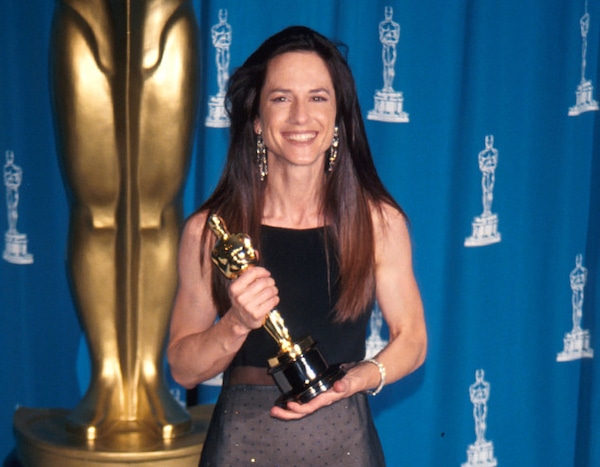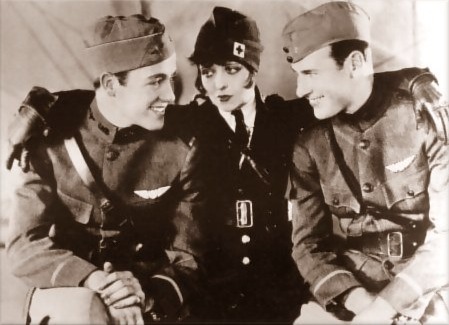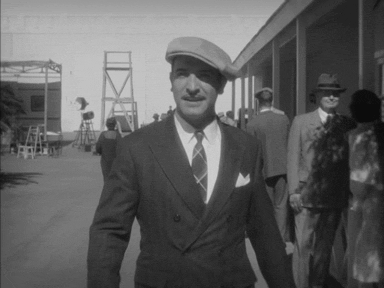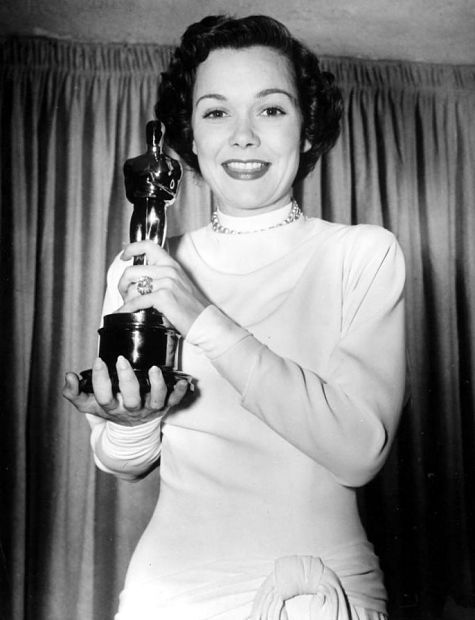O primeiro prêmio da Academia para Melhor Produção foi dado para o maravilhoso sucesso de público “Asas”
(1927). No ano seguinte, com o som invadindo Hollywood, o vencedor do prêmio
foi um musical, “Melodia da Broadway” (1929). Seriam necessários 83 anos para
que outro filme mudo levasse para casa o Oscar de Melhor Filme: “O Artista”, de
2011. Mas isso é uma curiosidade simples do Oscar.
The first Academy Award for Production was
given to the wonderful crowd pleaser “Wings” (1927). Next year, with sound
taking Hollywood by storm, the winner of the award was a musical, “The Broadway
Melody” (1929). It would take 83 years until another silent film took home the
Academy Award for Best Picture: 2011’s “The Artist”. But
this is basic Oscar trivia.
“Asas” conta a história de dois
amigos que vão para a Europa lutar na Primeira Guerra Mundial. Jack Powell
(Charles ‘Buddy’ Rogers) e David Armstrong (Richard Arlen) estão apaixonados
pela mesma garota. Entretanto,
a rivalidade no amor não acaba com a amizade, que na verdade fica mais forte
quando eles vão servir a aeronáutica do outro lado do Atlântico. Mary Preston
(Clara Bow), uma moça apaixonada por Jack, também vai para o front como
enfermeira. “Asas” também ganhou o Oscar de Melhores Efeitos de Engenharia -
prêmio dado apenas na primeira cerimônia.
“Wings” is the story of two friends who go to
Europe fight in World War I. Jack Powell (Charles ‘Buddy’ Rogers) and David
Armstrong (Richard Arlen) are in love for the same girl. However, the romantic
rivalry doesn’t end the friendship, and it actually becomes stronger because of
their serving together overseas as airplane pilots. Mary Preston (Clara Bow), a
girl in love with Jack, also goes to the front as a nurse. “Wings” also won the
Oscar for Best Engineering Effects - an award given only in the first ceremony.
“O Artista” conta a história de como
a chegada do som afetou a carreira do astro de cinema Georges Valentin (Jean
Dujardin). Concomitantemente, uma novata cheia de esperanças e sonhos, Peppy
Miller (Bérenice Bejo), chega em Hollywood com o objetivo de se tornar estrela
de cinema. Como uma carta de amor ao cinema mudo e aos bravos astros que
enfrentaram a transição para o cinema falado, “O Artista” ganhou,
merecidamente, cinco Oscars.
“The Artist” is the story of how the arrival of
sound shook the career of screen idol Georges Valentin (Jean Dujardin). At the
same time, a newcomer full of hopes and dreams, Peppy Miller (Bérenice Bejo),
arrives in Hollywood with the goal to become a movie star. As a love letter to
silent cinema and those brave stars that faced the transition to sound, “The
Artist” won, deservedly, five Oscars.
Antes de “O Artista”, o último filme
mudo indicado ao Oscar de Melhor Filme havia sido “O Patriota” de 1928, hoje
parcialmente perdido. Em outras categorias, os cineastas podem experimentar com
mais liberdade, e acabam criando pequenas obras-primas silenciosas. Na
categoria de Melhor Curta-metragem de Animação, por exemplo, tivemos vários
vencedores quase mudos nos últimos anos. A lista de charmosas pequenas
animações que não precisaram de palavras para contar uma história inclui The
Fantastic Flying Books of Mr Morris Lessmore (2011, com um protagonista igual
ao Buster Keaton), Paperman (2012, quase completamente em preto e branco), O
Banquete (2014) e Piper (2017).
Before “The Artist”, the latest silent Best Picture
nominee had been 1928’s “The Patriot”, a film now partially lost. In other
categories, filmmakers can experiment more freely and end up making little
silent masterpieces. In the Best Animated Short Film category, for instance,
there had been several near-silent winners in the past few years. The list of
charming short animations that needed no words to tell a story include The
Fantastic Flying Books of Mr Morris Lessmore (2011, with a Buster Keaton
lookalike lead), Paperman (2012, also almost completely in black and white),
Feast (2014) and Piper (2017).
 |
| Paperman |
Nenhum filme mudo ganhou na categoria
Melhor Filme em Língua Estrangeira, embora a Espanha tenha submetido o
maravilhoso “Blancanieves” para o Oscar de 2015 - ele sequer foi indicado.
Curtas-metragens live action foram por mais de 20 anos divididos em duas
categorias: um rolo e dois rolos, até que a categoria foi unificada em 1958.
Recentemente, a categoria se expandiu, indicando e premiando produções mais
experimentais de vários países. Um dos indicados de 2019 é o francês “Fera”,
que quase não tem diálogo em seu clímax.
No silent film has won in the category Best Foreign
Language Film, although Spain submitted the breathtaking “Blancanieves” for the
2015 Oscars - it wasn’t even nominated. Short live action films were for more
than 20 years divided in two categories: one-reel and two-reel, until the
category was unified in 1958. Recently, the category has expanded, nominating
and awarding more experimental films from all over the world. A short live
action film nominated in 2019 is the French “Fauve”, with almost no dialogue in
its climax.
A Academia em geral fica com a
escolha mais óbvia na categoria de Melhor Filme de Animação, premiando ou
sucessos de público ou, com mais frequência, filmes da Disney. No entanto, ela
ainda indica animações com escolhas mais ousadas para contar uma história. Dois
exemplos foram o inovador “O Menino e o Mundo” (2015) e o adorável “A Tartaruga
Vermelha” (2016), um filme completamente silencioso sobre um náufrago e a
tartaruga que ele encontra na ilha que é agora seu lar.
The Academy usually plays safe in the Best Animated
Feature category, choosing either crowd pleasers or, more frequently, Disney
movies. However, it still nominates animated films with more daring approaches
to storytelling. Two examples are the innovative “Boy and the World” (2015) and
the lovely “The Red Turtle” (2016), a completely silent film about a man adrift
and the turtle he meets in the island that is now his home.
 |
| The Red Turtle |
Às vezes não é um filme silencioso
que é reconhecido pela Academia, mas uma performance silenciosa. Papéis sem
falas indicados ao Oscar ao longo dos anos incluem personagens mudos como
Belinda McDonald (Jane Wyman em “Belinda”, 1948), Hellen Keller (Patty Duke em
“O Milagre de Anne Sullivan”, 1962), John Singer (Alan Atkin em “Por que tem de
ser assim?”, 1968), Michael (John Mills em “A Filha de Ryan”, 1970), Sarah
Norman (Marlee Matlin em “Filhos do Silêncio”, 1986), Ada McGrath (Holly Hunter
em “O Piano”, 1993), Hattie (Samantha Morton em “Poucas e Boas”, 1999), o Renter
(Max Von Sydow em “Tão forte e tão perto”, 2011) e Elisa Esposito (Sally
Hawkins em “A Forma da Água”, 2017). Matlin, uma atriz surda, ganhou o prêmio e
até hoje mantém o recorde de mais jovem ganhadora do Oscar de Melhor Atriz.
Outros astros que ganharam o Oscar por suas atuações silenciosas foram Jane
Wyman, Patty Duke, John Mills e Holly Hunter.
Sometimes it’s not a silent film that is recognized
by the Academy, but a silent performance. Non-speaking roles that were
nominated over the years include mute characters like Belinda McDonald (Jane
Wyman in “Johnny Belinda”, 1948), Hellen Keller (Patty Duke in “The Miracle
Worker”, 1962), John Singer (Alan Arkin in “The Heart is a Lonely Hunter”,
1968), Michael (John Mills in “Ryan’s Daughter”, 1970), Sarah Norman (Marlee
Matlin in “Children of a Lesser God”, 1986), Ada McGrath (Holly Hunter in “The
Piano”, 1993), Hattie (Samantha Morton in “Sweet and Lowdown”, 1999), the
Renter (Max Von Sydow in “Extremely Loud and Incredibly Close”, 2011) and Elisa
Esposito (Sally Hawkins in “The Shape of Water”, 2017). Matlin, a hearing
impaired actress, actually won the award and until today she holds the record
as the youngest Best Actress winner. Other performers that won the Oscars for
their silent performances were Jane Wyman, Patty Duke, John Mills and Holly
Hunter.
 |
| Patty Duke |
 |
| John Mills |
 |
| Marlee Matlin |
 |
| Holly Hunter |
A Academia não é perfeita, e está
evoluindo lentamente. A arte de se fazer filmes evoluiu, e hoje fazer um filme
mudo é tanto uma escolha quanto um manifesto. Pelo menos, a Academia está,
pouco a pouco, reconhecendo os melhores esforços levados a cabo com pouco ou
nenhum diálogo. Afinal, se temos rostos, do que mais precisamos?
The Academy is not perfect, and it’s slowly
evolving. Filmmaking has evolved, and now making a silent film is both a choice
and a statement. At least, the Academy is, little by little, recognizing the
best efforts made with little or no dialogue. After all, if we have faces, what
else do we need?
This is my contribution to the 31 Days of Oscars
blogathon, hosted by Aurora at Once upon a Screen, Kellee at Outspoken & Freckled and Paula at Paula’s Cinema Club.








2 comments:
This was an interesting post and a very inspired topic. I love silent films.
I also invite you to read my contribution to the blogathon.
https://crystalkalyana.wordpress.com/2019/02/24/the-heiress-1949-a-second-academy-award-for-olivia-de-havilland/
Silence is golden, and your look at the Academy and silence in cinema through the years is a very interesting article. Thank you for highlighting the interesting work being done in the animation field.
Post a Comment